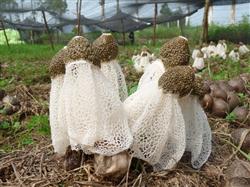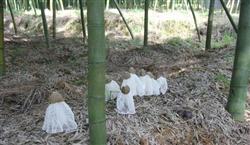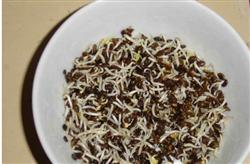How to grow Dictyophora artificially?

How to grow Dictyophora artificially? Please give me the introduction method Dictyophora, known as the title of "king of edible fungi". It is delicious and nutritious, and it is a popular commodity in the international and domestic market. According to analysis and testing, Dictyophora contains eight essential amino acids, long-term consumption can inhibit the rise of blood pressure and reduce the content of cholesterol in the blood, so it is a promising edible fungus. At present, there are more than ten species of Dictyophora at home and abroad, but due to the influence of climate and environment, there are only a few species suitable for cultivation in the north of China, such as long skirt Dictyophora, short skirt Dictyophora, red Dictyophora and so on. 1. Cultivation 1. Raw material cultivation: (1) selection of raw materials: there are a wide range of raw materials suitable for Dictyophora cultivation, such as broad-leaved tree sawdust, cottonseed shell, crop straw, bamboo and so on. (2) Raw material treatment: the selected raw material is crushed into a final shape (such as sawdust) and treated in two ways. Soak in ① lime water. Soak the raw material in 0.3% 0.5% lime water, stir, soak for about 1-2 minutes, then remove it into the basket and rinse with clean water. The pH value is about 7. Then control the raw material to about 65% water content and then inoculate. ② drug treatment method. Soak the raw material with 800 times of carbendazim or topjin solution to make the solution higher than the slope. Remove and control the excess water in 2 minutes, so that the water content is about 65% and can be inoculated. (3) cultivation method: first combine formaldehyde for cultivation room with potassium permanganate, after fumigation and disinfection, spread film on the cultivation box, put on a layer of sandy soil, and then layer by layer of bacteria, yellow 2-layer 3 layer. The thickness of the material is about 25 cm, usually 2-3 bottles of Dictyophora bacteria are used in the square meter. Wrap it in plastic film after inoculation. 2. Clinker cultivation: (1) raw material treatment: add 18% wheat bran or rice bran, 2% cornmeal, 0.3% urea, 1.5% calcium superphosphate, 0.3% sulfuric acid, add water and then mix well, so that the water content can be reached when the finger seam is held by hand. (2) High temperature sterilization: put the mixed raw materials into a high temperature sterilization pot, when the temperature rises to 100℃, steam for 5 hours for 6 hours and wrap them in a pre-laid plastic film. (3) cultivation method: when the feed temperature dropped below 30 ℃, open the wrapped film, insert the bacteria and then wrap the film. 2. Management 1. Ecological conditions: (1) temperature: the growth temperature of Phyllostachys pubescens mycelium is 25-32 ℃, and the optimum temperature is 23-24 ℃. The growth and development temperature of fruiting body is between 15-28 ℃, and the optimum temperature is 22-25 ℃. When the mycelium was more than 32 ℃ or less than 5 ℃, the mycelium growth was slow or stopped. (2) humidity: the humidity of mycelium growth is between 60% and 70%, and the humidity of growth and development of buds is in the range of 75% and 95%, while when breaking balls and spreading skirts, the relative humidity should be 85%, 95% is the best, and the humidity is less than 80%. The fruiting body is difficult to form or deform. (3) Air condition: Dictyophora is a kind of aerobic fungus, it needs enough fresh air during its growing period, and attention should be paid to ventilation inside. (4) Light condition: light can inhibit the growth of Dictyophora, so the growth of mycelium does not need light. The growth and development of the fruiting body requires scattered light. (5) nutritional conditions: the nutrients used for the growth of Dictyophora are mainly carbon and ammonia sources, followed by inorganic salts and trace vitamins. The dead bodies of plants, such as sawdust and straw, are the nutrients it needs. In the reproductive growth stage of Dictyophora, a little peat soil is needed. 2. Management method: within 3-4 days after planting, the temperature should be kept between 24-27 ℃. After a period of mycelium growth, when the hyphae grow on the surface of the culture medium, cover with a layer of humus soil (that is, soil for growing flowers). After covering, keep the air fresh in the room, ventilate and breathe every day, and keep the cover wet soil, the temperature is kept at 22 ℃, and the relative humidity is kept between 85% and 95%. Usually, the hyphae develop for 1 to 2 months, that is, the hyphae extend to the soil surface, when the temperature is between 23 and 26 ℃, the relative humidity is constant, giving a certain amount of scattered light, and after 5 days, small white spots appear on the surface. It proves that the primordium of the fruiting body is formed. During the growth and development of the fruiting body, the relative humidity should be 80% 95%. It takes 40 to 80 days from budding to maturity, which depends on the temperature. The relative humidity reaches 95%, and the intensity of the bacterial skirt is the strongest. Harvesting and processing when Dictyophora skirt opens its umbrella and the spores autolyze, harvest immediately, remove the cap and receptacle, and then dry them respectively (either in the sun or in the oven). After making the dry product, tie it into a bundle of 50 grams with red rope, seal it in a polyethylene non-toxic double-layer food bag, and then store it in a jar with hygroscopic agent, waiting for sale. Click to get more planting techniques of Dictyophora, click to get more planting techniques of edible fungi
- Prev

Introduction: planting technology of edible mushroom Dictyophora
Dictyophora is graceful, nutritious, delicious and delicious. It is a valuable edible fungus, known as "fungal flower" and "queen of fungi". 1. Biological characteristics 1. Morphology. Dictyophora, also known as bamboo ginseng, bamboo sheng, fairy Sheng, bamboo girl and bamboo egg, belongs to basidiomycetes, ghosts.
- Next

What method does astragalus seed have to deal with?
What method does astragalus seed have to deal with? Please introduce the method that astragalus seeds are hard and solid, and the hard seed rate is generally 40% 80%. The emergence rate is low after sowing. Seed treatment must be carried out before sowing to break the impermeability of seeds and improve the emergence rate of sowing. There are three methods of seed treatment, one of which can be chosen. 1 、...
Related
- Fuxing push coffee new agricultural production and marketing class: lack of small-scale processing plants
- Jujube rice field leisure farm deep ploughing Yilan for five years to create a space for organic food and play
- Nongyu Farm-A trial of organic papaya for brave women with advanced technology
- Four points for attention in the prevention and control of diseases and insect pests of edible fungi
- How to add nutrient solution to Edible Fungi
- Is there any good way to control edible fungus mites?
- Open Inoculation Technology of Edible Fungi
- Is there any clever way to use fertilizer for edible fungus in winter?
- What agents are used to kill the pathogens of edible fungi in the mushroom shed?
- Rapid drying of Edible Fungi

